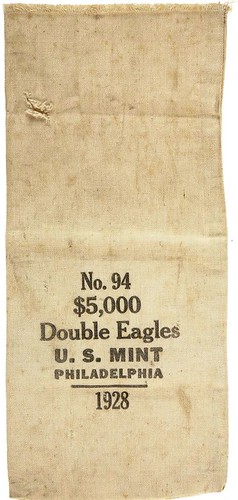
About UsThe Numismatic Bibliomania Society is a non-profit organization promoting numismatic literature. For more information please see our web site at coinbooks.org SubscriptionsThose wishing to become new E-Sylum subscribers (or wishing to Unsubscribe) can go to the following web page link MembershipThere is a membership application available on the web site Membership Application To join, print the application and return it with your check to the address printed on the application. Membership is only $15 to addresses in the U.S., $20 for First Class mail, and $25 elsewhere. For those without web access, write to: David M. Sundman, Secretary/TreasurerNumismatic Bibliomania
Society AsylumFor Asylum mailing address changes and other membership questions, contact David at this email address: dsundman@LittletonCoin.com SubmissionsTo submit items for publication in The E-Sylum, just Reply to this message, or write to the Editor at this address: whomren@coinlibrary.com
BUY THE BOOK BEFORE THE COINYou won't regret it! |
- WAYNE'S WORDS: THE E-SYLUM OCTOBER 2, 2011
- LAKE BOOKS 109TH MAIL BID SALE CLOSES OCTOBER 4, 2011
- SKLOW MAIL BID SALE #14 CLOSES OCTOBER 15, 2011
- NEW BOOK: NEW JERSEY COPPERS BY MICHAEL A. DEMLING
- NEW EDITION: CHERRYPICKERSâ GUIDE, FIFTH EDITION, VOLUME II
- NEW EDITION: UNUSUAL WORLD COINS, 6TH EDITION
- LANGE PROGRESSES IN RESEARCH ON COIN ALBUM HISTORY
- SPINK TO OFFER THE ALEXANDER MEDALLION BOOK
- INTERESTING LIBERTY SEATED LOOKALIKE TOKEN
- EXHIBIT: MONEY AND BEAUTY
- FIRST MINT DIRECTOR DAVID RITTENHOUSE REINCARNATED IN PHILADELPHIA
- QUERY: AUCTION CATALOGS SOUGHT FOR ANA LIBRARY
- QUERY: 1872 INTERNATIONAL PEACE JUBILEE MEDAL ENGRAVER SOUGHT
- QUERY: MARKINGS ON U.S. MINT COIN BAGS
- MORE ON THE PHILADELPHIA MINT EMPLOYEE ERROR COIN THEFT
- NEWS AND SPECULATION SURROUNDS EXIT OF ANA EXECUTIVE DIRECTOR
- STILL MORE ON SECRET COMPARTMENT COINS
- MORE ON SO-CALLED DOLLARS, INCLUDING A NEW BOOK
- NOTES FROM E-SYLUM READERS: OCTOBER 2, 2011
- QUERY: HELP DECIPHER NORTH CAROLINA STATE TREASURY NOTE SIGNATURE
- MORE ON VICTOR JANVIER
- SS GAIRSOPPA SHIPWRECK DISCOVERED BY ODYSSEY MARINE
- OBAMA AWARDS NATIONAL MEDALS OF SCIENCE AND TECHNOLOGY
- BOULTON AND WATT TO GRACE NEW £50 BANKNOTE
- AMAZON'S INCREDIBLE E-BOOK SALES GROWTH
- FROME HOARD OF ROMAN COINS DISPLAYED FOR PUBLIC
- DOWNIES EMPLOYEE STOLE COINS TO BUY SPORTS CARDS
- FEATURED WEB PAGE: 1715 FLEET SOCIETY
WAYNE'S WORDS: THE E-SYLUM OCTOBER 2, 2011

Among our new subscribers this week are Ron Alexander, William Ferry and Charles Cave. Welcome aboard! We have 1,456 email subscribers, plus 165 followers on Facebook, including Steve Cooper and Roscoe A. Shepherd.
First, a note about next week's issue. I'll be traveling next Sunday, making publishing at the normal time more difficult. I may publish a day early, so please get any replies and submissions to me early this week. But if I can't wade through the pile fast enough, the issue may be delayed until Monday night. So please be patient if your issue doesn't arrive on time.
This week we open with sale reminders from literature dealers Fred Lake and David Sklow, followed by items on five new or upcoming numismatic books. Other topics this week include an interesting coin lookalike token, hard-to-read signatures on paper money and medals, and the incredible sales rate of e-books.
To learn more about Victor Janvier, raising Rittenhouse from the dead, and the former Mint employee who âainât talking to nobody,â read on. Have a great week, everyone!
Wayne Homren
Numismatic Bibliomania Society
LAKE BOOKS 109TH MAIL BID SALE CLOSES OCTOBER 4, 2011
This is a reminder that our 109th mail-bid sale of numismatic literature closes on Tuesday, October 4, 2011 at 5:00 PM (EDT). The 544-lot sale features selections from the library of Dr. Allen Axenfield and encompasses all areas of the numismatic experience.
You may view the sale at www.lakebooks.com/current.html and bids may be placed until the closing time via email, fax or telephone. Good luck with your bidding. Cordially, Fred
Lake Books
6822 22nd Ave. N.
St. Petersburg, FL 33710
727-343-8055 Fax 727-345-3750
SKLOW MAIL BID SALE #14 CLOSES OCTOBER 15, 2011
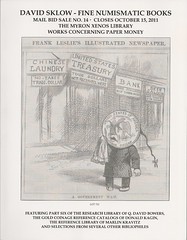 I wanted to send a reminder that MBS # 14 closes at 8 pm MT Saturday October 15.
The sale spans 1022 lots, with something for nearly everyone!
Here are some highlights:
I wanted to send a reminder that MBS # 14 closes at 8 pm MT Saturday October 15.
The sale spans 1022 lots, with something for nearly everyone!
Here are some highlights:
⢠Featuring the Paper Money works from the Library of Myron Xenos
⢠Early Convention Programs of the American Numismatic Association
⢠A very nice [high quality] run of History of the U. S. Mint by Evans
⢠Early Red Books by Yeoman
⢠Long run of the works of John Muscalus
⢠Run of early 20th Century auction catalogs
⢠Long run of New Netherlands Sales
⢠Letters from Ten Different U. S. Senators [signed on official letterheads] concerning the 1965 Silver Coinage Act.
⢠A plated Chapman of the Boerum Sale
⢠Original 1865 Articles of Incorporation of the American Numismatic and Archaeological Society [ANS]
⢠Epochs in American Banking numbers 1-14 by Noble Foster Hoggson, 1927-28
⢠A few Medallic ANA pieces from M. Remy Bourne
⢠The Art of Coin Making by Cooper
⢠The Philadelphia Mint by James Rankin Young, 1903
⢠Super Deluxe Bowers and Merena Edition of the Norweb Sales, # 4 Raymond Merena's Copy
⢠Super Deluxe Bowers and Merena Edition of the Garrett Sales, # 2 Raymond Merena's Copy
⢠Part VI of the Q. David Bowers Research and Source Library with hundred lots on Numismatics
⢠A run of Bank Histories
⢠The Standard Reference Library of Marlin Kravitz
⢠The Private Gold reference catalogs from Donald & Art Kagin
⢠Deluxe Full Leather B. Max Mehl Catalog of the Morse, Faelton and Todd Collections 1936, the rarest of the Deluxe versions!
⢠Lyman Low Plated and priced Kingman sale 1899
⢠Strobridge Plated and priced Groux sale 1874
⢠Samuel Hatch priced and named sale Feb. 14, 1866 with addenda
⢠Strobridge Plated Furman sale Dec. 12, 1872 with original prices realized tipped in
⢠Strobridge Plated Clay sale Dec 5, 1871 priced and named
⢠Strobridge Catalog of Joseph Gay's collection Thick Paper
⢠Bangs, Merwin & Co. Addenda to the Bogert Sale Feb. 28, 1859 11 pages, 331 lots
⢠Bangs, Merwin & Co. Sale The Cabinet of James Oliver June 3, 1868 Priced & Named
⢠Cogan catalog of a Private Collection of United States Large Cents Nov. 1, 1858
⢠Leavitt Sale of T. P. Rossiter Feb. 5, 1873 one of ten thick paper & interleaved
⢠Augustus B. Sage Price list "No. 1" February 1859
⢠Leavitt & Co. Sale of Montgomery's Bond collection Ma7 7, 1870 Priced
⢠A Descriptive Catalogue of the Political and Memorial Medals Struck in Honor of Abraham Lincoln, 1873 by Andrew Zabriske, RARE.
⢠Vignette Book The Presidents of the United States, The Bureau of Engraving and Printing, presented to General Batcheller by his warm friend William M. Meredith, Chief of the Bureau, 1891.
Bidders may enter bids by mail, telephone, email or fax. The sale closes at 8pm mountain time, October 15, 2011, however, any bids left on our answering machines or sent by email or fax on or before midnight on closing day will be accepted. The auction catalog is viewable on our website.
David Sklow-Fine Numismatic Books
P.O. Box 6321
Colorado Springs, CO 80934
PH: 719-302-5686
FAX: 719-302-4933
EMAIL: numismaticbooks@aol.com
WEB: FineNumismaticBooks.com
NEW BOOK: NEW JERSEY COPPERS BY MICHAEL A. DEMLING
 New Jersey Coppers:
A Comprehensive Analysis and Attribution Guide of New Jersey Colonial Coppers
New Jersey Coppers:
A Comprehensive Analysis and Attribution Guide of New Jersey Colonial Coppers
Author: Michael A. Demling
Not since Dr. Edward Maris published his book âCoins of New Jerseyâ in 1881 has there been an updated work on these interesting colonial coins. The book consists of 227 pages in five chapters outlining attribution methods with charts and diagrams to assist in ones effort to determine the die varieties.
One of the most helpful aspects of the book is the last two chapters that are dedicated to the Obverse and Reverse die combinations. Each chapter shows a large photo of the specific Obverse die with its reverse die marriages. The same process is repeated in the next chapter for the Reverse / Obverse die marriages. This book is a great reference for collectors, colonial specialist, and dealers.
The book is 8 ½â x 11â spiral bound with five chapters totaling 227 pages. Itâs published and sold by the author and is available at $44.95 w/ $3.95 s&h Michael Demling, PO Box 211, Linwood, NJ 08221
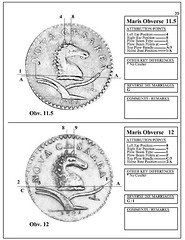
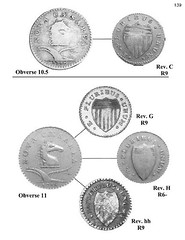
NEW EDITION: CHERRYPICKERSâ GUIDE, FIFTH EDITION, VOLUME II
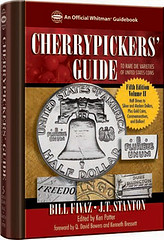 Whitman Publishing is releasing a new, expanded, and updated volume of the award-winning Cherrypickersâ Guide to Rare Die Varieties of United States Coins. The fifth edition, volume II, covers half dimes to silver and modern dollars, plus gold dollars through double eagles, commemoratives, and bullion. It will be available in November 2011, online (including at www.Whitman.com) and from booksellers, hobby shops, and coin dealers nationwide, for $39.95.
Longtime die-variety specialist Ken Potter has joined the Cherrypickersâ team as editor of the new volume, working with the bookâs original creators, Bill Fivaz and J.T. Stanton.
Whitman Publishing is releasing a new, expanded, and updated volume of the award-winning Cherrypickersâ Guide to Rare Die Varieties of United States Coins. The fifth edition, volume II, covers half dimes to silver and modern dollars, plus gold dollars through double eagles, commemoratives, and bullion. It will be available in November 2011, online (including at www.Whitman.com) and from booksellers, hobby shops, and coin dealers nationwide, for $39.95.
Longtime die-variety specialist Ken Potter has joined the Cherrypickersâ team as editor of the new volume, working with the bookâs original creators, Bill Fivaz and J.T. Stanton.
âCherrypickingâ involves examining coins that look normal at first glance, but have unusual characteristics (like doubled and tripled dies, overdates, and repunched mintmarks) that can reveal a common coin to be a rare and valuable variety. The Cherrypickersâ Guide includes close-up photographs and descriptions to guide the reader, plus market information and values in multiple grades, for more than 780 varieties. Appendices include essays on types of doubling, how to examine your coins, Proof set varieties, collector clubs, recommended reading, and other beginner and advanced topics.
Accurate pricing was an important goal for editor Ken Potter. âWe coordinated our pricing with input from dealers, collectors, and other hobby experts and specialists,â said Potter. âFor each variety we studied retail prices, coin-show activity, and real-world auction results, in detail, in order to report the most accurate values possible.â The new volume is 32 pages longer than the fourth edition, with more than 100 new varieties.
âMost of the additions are within the popular modern series,â said Whitman publisher Dennis Tucker. âWe have new Mercury dimes, more than a dozen each of new Roosevelt dimes and Kennedy half dollars, two dozen new Washington quarters, including State and National Park varieties, and new modern dollars. The entire bullion section is new, covering silver, gold, and platinum coins. And weâve included additional varieties in the older coinage series, as well.â The Cherrypickersâ Guide can be pre-ordered online before its November rollout, including at www.Whitman.com.
The Cherrypickersâ Guide to Rare Die Varieties of United States Coins, fifth edition, volume II
By Bill Fivaz and J.T. Stanton; edited by Ken Potter; forewords by Q. David Bowers and Kenneth Bressett
ISBN 079483239-3
Spiralbound hardcover
512 pages
Retail $39.95
For more information, or to order, see: www.whitmanbooks.com/Default.aspx?Page=81&ProductID=0794832393
NEW EDITION: UNUSUAL WORLD COINS, 6TH EDITION
The sixth edition of Unusual World Coins is now available from Krause Publications.
Edited by George Cuhaj and Tom Michael, the new edition is bigger and better than ever with more than 150 more pages, 1,250 new images and more than 700 new issues than the previous edition.
The classic guide to mysterious coin issues from the realms of Fantasy, the borders of Micro-Nations, the halls of Exiled Royalty, the shady backrooms of imitators, the creative minds of numismatic promoters and the shores of Islands as yet undiscovered has grown and the market for these types is hotter than ever.
Within this volume you can tap into a numismatic world sparkling with flare and enchantment, bubbling with inventiveness and simmering with independence.
In this new edition you will discover:
- New countries never before detailed in any catalog
- Up to date prices for this exploding market
- More photographic images
- New coin issues with full descriptions
For more information visit www.sellcoinbooks.com/world-coin-books/unusual-world-coins-6th-edition .
LANGE PROGRESSES IN RESEARCH ON COIN ALBUM HISTORY
In the Fall 2011 issue of his Coin Board News, David Lange writes:
Progress continues on my coin album book, which I now anticipate publishing in several volumes due to its growing size. Volume One will include the products of the Beistle Company, Wayte Raymond, Inc. and M. Meghrig & Sons. These three companies marketed essentially the same coin album over a period of 35 years, best known to collectors as the National Coin Album. The complete history and catalog of this series will be included, along with all other coin albums and folders to come from these companies.
For more information, see: coincollectingboards.net
SPINK TO OFFER THE ALEXANDER MEDALLION BOOK
A number of readers have been asking where to purchase copies of the new book by Frank Holt and Osmund Bopearachchi, "The Alexander Medallion. Exploring the origins of a unique artefact". According to coauthor Bopearachchi (via Kavan Ratnatunga nd Bill Daehn), "The book will be distributed by the Spinks". It is not yet on the firm's web site, but stay tuned.
Howard Cohen adds:
The ISBN number for the book is 978-2-95166-796-9
To read an earlier E-Sylum article, see: NEW BOOK: THE ALEXANDER MEDALLION BY HOLT AND BOPEARACHCHI (www.coinbooks.org/esylum_v14n38a05.html)
To visit the Spink web site, see: www.spink.com
THE BOOK BAZARRE
INTERESTING LIBERTY SEATED LOOKALIKE TOKEN
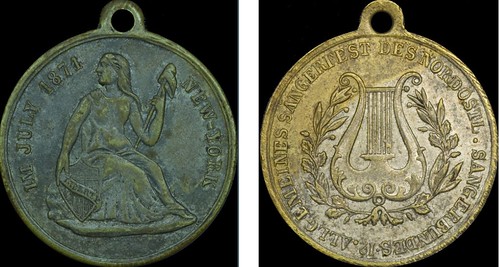
The token was issued in conjunction with the 1871 New York convention of a German-American singing society. The harp on the reverse is symbolic of the musical theme, while the legends are in German. The use of the Liberty Seated figure is interesting â" in this case, she is the symbol not of Liberty, but of American Liberty in particular.
The Liberty Seated figure was 35 years old on American coinage at this time, and by evoking the standard bearer of American silver money the German immigrant community acknowledged their new homeland. The token designer has thus ably incorporated important themes of the organization â" music, Germanic background, and American Liberty.
While the design is noteworthy, the execution is not so much - the portrait of Liberty is somewhat crude while a reverse die break causes two strings of the harp to join together (which if you think about it would not make for a very good sounding harp). The reverse legend reads:
ALLGEMEINES SANGERFEST DES NORDOST [German Festival Singers of the Northeast]
SANGERBUNDES 12 [probably referring to the 12th such singing conference]
Thanks to John Baumgart for the photographs of this token.
EXHIBIT: MONEY AND BEAUTY
John Sallay writes:
 This is a little tangential to numismatics, but possibly of interest to readers of The E-Sylumâ¦
My wife saw a review in the September issue of Art & Antiques magazine describing a recently-opened art exhibition related to money and banking. The Palazzo Strozzi museum in Florence just opened âMoney and Beauty: Banking, Botticelli and the Bonfire of the Vanitiesâ on September 17, running through January 22, 2012. Iâve attached a photo of one of the paintings in the show.
This is a little tangential to numismatics, but possibly of interest to readers of The E-Sylumâ¦
My wife saw a review in the September issue of Art & Antiques magazine describing a recently-opened art exhibition related to money and banking. The Palazzo Strozzi museum in Florence just opened âMoney and Beauty: Banking, Botticelli and the Bonfire of the Vanitiesâ on September 17, running through January 22, 2012. Iâve attached a photo of one of the paintings in the show.
In northern Italy in the 14th century, bankers had a problem. With the increasing sophistication of currency systems and the growth of international trade, huge new opportunities were afoot to make money by manipulating money. However, there was a catch: Lending money at interest was against the Catholic religion, whose theologians labeled it âusury,â a sin deserving damnation. Canny financiers with one eye on their coffers and the other on what would happen after they were in their coffins came up with some interesting ways around this impasse.
One was to exploit slight differences in foreign countriesâ exchange rates to generate returns on investment of up to 29 percent. With this practiceâ"a version of what today would be called arbitrageâ"they could claim that technically no interest had been charged and thus be off the hook with the Church hierarchy. Another, very different strategy was to launder the lucre by converting it into art. That would have two outcomes. By commissioning altarpieces and other public religious art, bankers like Cosimo deâ Medici could assuage their guilt and at the same time impress their fellow citizens with their piety. Not only that, but by using financial clout to influence the iconography of these works, they could subtly send a message to the populace that maybe money wasnât so bad after all, spiritually speaking. By making sure that the Virgin was portrayed in sumptuous garments even if she happened to be in a manger, by having themselves painted into holy scenes hobnobbing with saints and angels, and even by putting religious imagery on coins, the wealthy were engaging in highly effective propaganda for their profession.
The fruitful if often uncomfortable relationship between art and money in early Renaissance Florence is the subject of âMoney and Beauty: Bankers, Botticelli and the Bonfire of the Vanities,â a fascinating exhibition opening this month in that cityâs Palazzo Strozzi museum, co-curated by author Tim Parks and art historian Ludovica Sebregondi. Paintings by artists from Botticelli to Ghirlandaio to Fra Angelico (plus a sampling of pictures by non-Florentines such as Quentin Matsys and Hans Memling) are displayed alongside objects like coins, gold-weighing devices and a bale of raw wool, as well as contemporary financial documents, to tell a complex story from a little-read chapter of cultural history.
The idea for the show dates back to a book Parks published in 2005 called Medici Money. âOriginally I was asked to write this book by W.W. Norton, who were doing a series on money issues,â recalls Parks, an English-born novelist, travel writer and translator (notably of the wonderful and uncategorizable books of Roberto Calasso) who has been living in Italy for the past 30 years. ââNo way,â I said, âtoo complex.ââ But Parks was persuaded, and the book did well. Several years later, the Palazzo Strozzi got in touch with him and asked if he would be interested in collaborating on an exhibition that would essentially illustrate and extend the points he made about money and art in his book. Since Parks is not an art historian, Sebregondi came on board to lend scholarly expertise and use her curatorial connections to negotiate the impressive roster of loans for the show. The exhibition is structured as a âduet,â and the two curators wrote double captions for all the works.
To read the complete review, see: Holy Money (www.artandantiquesmag.com/2011/09/holy-money/)
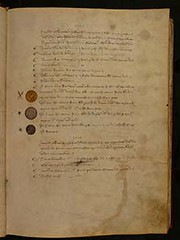 The Fiorinaio is a register containing copies of the various coins struck in Florence from the 13th to the 19th century, arranged in chronological order and interspersed by reports on appointments of the officials responsible for coinage, and rules governing their activity. These officials, called Signori della Moneta up to 1373 and Ufficiali della Zecca afterwards, were entitled to choose the symbols and decoration imprinted on the coins struck during their term of office.The register was begun in the month of March 1317 by Ser Salvi Dini, at the time notary to the mint officials. On the first pages he transcribed earlier information and documents, dating back to1252, the year when the first gold florin was struck, and then continued to record current entries up to 1321 (fol. 11v). After this date the register was kept by others until 1834.
The Fiorinaio is a register containing copies of the various coins struck in Florence from the 13th to the 19th century, arranged in chronological order and interspersed by reports on appointments of the officials responsible for coinage, and rules governing their activity. These officials, called Signori della Moneta up to 1373 and Ufficiali della Zecca afterwards, were entitled to choose the symbols and decoration imprinted on the coins struck during their term of office.The register was begun in the month of March 1317 by Ser Salvi Dini, at the time notary to the mint officials. On the first pages he transcribed earlier information and documents, dating back to1252, the year when the first gold florin was struck, and then continued to record current entries up to 1321 (fol. 11v). After this date the register was kept by others until 1834.
To read the complete article, see: Striking Coins in Florence (www.coinsweekly.com/en/Article-of-the-week/5)

For more information on the exhibit, see: Money and Beauty. Bankers, Botticelli and the Bonfire of the Vanities (www.palazzostrozzi.org/SezioneDenaro.jsp?idSezione=1214)
FIRST MINT DIRECTOR DAVID RITTENHOUSE REINCARNATED IN PHILADELPHIA
Earlier this week I initiated an email exchange with David Crenshaw of Whitman, Len Augsburger and Joel Orosz about the actor who played the part of David Rittenhouse in an interview with Len and Joel. I wrote:
Iâm sorry I missed the Philadelphia show. I saw the Coin World article about the Rittenhouse interview and wanted to say I thought that was a wonderful idea. Iâll bet it was fun.
One of the best ANA Numismatic Theatre presentations I attended was Don Kagin playing âthe worldâs oldest prospectorâ. It's a great way to present history in a first person manner.
Joel replied:
It was a great show. The actor who played Rittenhouse was extremely talented, and did a superb job. Len and I prepared a script, with both our questions and his suggested answers. He memorized the script, and threw in some witty ad-libs of his own. The "interview" was lightly attended, but fortunately, Whitman filmed it.
Len added:
It was a big hit, this guy was really good.
David Crenshaw wrote:
I, also, thoroughly enjoyed the program. People donât know what theyâre missing when they donât attend these programs. The one last year where Jefferson debated Hamilton about the Constitution among other things was very enlightening. I only wish we had video it as well. Maybe weâll have to have them back to do it again. See whitmancoincollecting.com/content/jefferson-vs-hamilton-at-the-whitman-philly-expo .
The Rittenhouse digital video is now being processed for inclusion on our site.
QUERY: AUCTION CATALOGS SOUGHT FOR ANA LIBRARY
Donald G. Tritt writes:
The following catalogs are not in the ANA library. I am hopeful someone on your subscriber list might have or know of a copy of the following catalogs:
1) The 1999 multi-part catalog for the collection of Dr. Irving N. Schuster.
2) The Broadway sale/catalog of October, 1986.
Regrettably, I do not know the names of the auction houses. I realize this makes a search quite difficult. For #1 I hope the name "Dr. Irving N. Schuster" coupled with "1999" will trigger a memory by someone. For #2 I hope a combination of the sale title "Broadway" coupled with the date of "October 1986" will shake loose a memory.
QUERY: 1872 INTERNATIONAL PEACE JUBILEE MEDAL ENGRAVER SOUGHT
Dave Bowers writes:
I have an inquiry. In studying a die made for the International Peace Jubilee in Boston in 1872 I cannot decipher the engraverâs name, which is reproduced on attached pictures. Can anyone help?
![sc B-MA-330 . MA, Boston . International Peace Jubilee r scmirror [qdb] DIFF](http://farm7.static.flickr.com/6159/6205881984_f2820eb352_m.jpg)
![sc B-MA-330 . MA, Boston . International Peace Jubilee r scmirror [qdb]](http://farm7.static.flickr.com/6163/6205876944_986af26b64.jpg)
QUERY: MARKINGS ON U.S. MINT COIN BAGS
One lot in the Duckor Collection of double eagles is a U.S. Mint bag for $5,000 in 1928 double eagles. The bag is imprinted âNo. 94â as shown in the attached photo. Can anyone tell me what âNo. 94â represents?
Bill Fivaz wrote:
The only guess that I would have is the obvious - that it was the 94th bag of that date that was assembled.
Roger Burdette wrote:
The number "94" on the 1928 double eagle bag is the delivery number. This was done so that if there was a problem with the Special Assay for that delivery, the coins could be easily identified and sequestered pending further tests. In this instance, delivery #94 occurred on April 24, 1928.
[Ref: Burdette: Annual Assay Commission of the United States Mint 1800-1943. Meeting minutes for CY 1928 (FY 1929 meeting), page 6.]
Hope this helps! If so please send me some of the coins from the bag!
Mark Borckardt wrote:
Thanks to several of you who replied with your thoughts and comments, and especially to Roger Burdette. I continue to be amazed at the substantial cumulative knowledge of the membership and am so proud to be counted among all of you.
MORE ON THE PHILADELPHIA MINT EMPLOYEE ERROR COIN THEFT
 Mint police officer William Gray, 64, pleaded guilty in September to stealing an estimated 32,000 defective coins, federal court records in Camden show.
Mint police officer William Gray, 64, pleaded guilty in September to stealing an estimated 32,000 defective coins, federal court records in Camden show.
Gray sold the coins to a California collector for as much as $75 apiece, court records show. The theft prompted the agency to conduct a security review at all six of its minting facilities nationwide, spokesman Michael White said. Tourists at the U.S. Mint must pass through metal detectors and leave their cameras at the door before they can watch the coining process from behind glass walls.
Neither the U.S. Mint nor the U.S. Attorneyâs Office would say how the theft of so much currency from a facility as famed for its security went undiscovered for three years. Gray would not divulge his secret either.
âI ainât talking to nobody,â Gray said when reached for comment at his North Wildwood home. He remains free on $50,000 bail until his Dec. 20 sentencing before U.S. District Court Judge Noel L. Hillman in Camden.
Gray retired as a Philadelphia police officer after 26 years before joining the mint, where he worked from 1996 to January 2011.
He began stealing from the nationâs largest mint in 2007 when it released new $1 coins featuring the portraits of American presidents, court records show. Over the next three years, prosecutors said, he hid defective coins in containers that he smuggled out of the mint for sale to an unnamed collector in California.
Gray mailed the coins from the Middle Township Post Office in Rio Grande near his North Wildwood home to a coin distributor in California who specialized in selling these kinds of defective coins, court records said.
This distributor sent Gray 50 checks totaling $2.4 million. Gray faces charges of income-tax evasion for allegedly not reporting this income, prosecutors said.
He faces as long as 20 years in prison at sentencing and must pay back the $2.4 million value of the coins in monthly installments of $1,000. At this rate, it would take the government 200 years to recoup the stolen proceeds. As part of his plea agreement, Gray must forfeit two homes he owns in Philadelphia along with five vehicles, including a 2010 Lincoln MKS, and a small fishing boat. He can keep his North Wildwood home, which is his primary residence. Meanwhile, U.S. Mint officials said they are taking steps to close loopholes in their security.
To read the complete article, see:
U.S. Mint reviewing security after Cape May County man steals $2.4 million in coins
(www.pressofatlanticcity.com/news/breaking/u-s-mint-reviewing
-security-after-cape-may-county-man/article_
5dacb66e-ebb7-11e0-9c10-001cc4c03286.html)
NEWS AND SPECULATION SURROUNDS EXIT OF ANA EXECUTIVE DIRECTOR
Paid administrative leave has turned into unemployment for American Numismatic Association executive director Larry Shepherd.
ANA President Tom Hallenbeck made the news public in a telephone conference call to the numismatic press Sept. 28.
Hallenbeck said he would attend an ANA staff meeting later that afternoon to tell the organizationâs employees of the decision of the ANA board of governors.
In the words of the official press release, âThe American Numismatic Association Board of Governors today announced that it has ended its employment relationship with Larry Shepherd as executive director.â
To read the complete article, see:
No Return for Shepherd
(www.numismaster.com/ta/numis/Article.jsp?ad=article
&ArticleId=24156&et_mid=520645&rid=2226673)
Scott Barman, in his September 28, 2011 Coin Collector's Blog writes:
âWe appreciate Shepherdâs past three years of contributions, but the Board determined the association needs to move in a different direction going forward, providing greater focus on its core educational mission,â said ANA President Tom Hallenbeck
This is the first that has been reported that the Board or anyone else felt that not enough emphasis was being placed on ANAâs educational efforts. But it appears that the Board is not happy with the increased attention to the shows. In the succeeding paragraph, Hallenbeck was quoted as saying:
The ANA is about more than just being a big coin show. Itâs about our individual members and member clubs. Itâs about educating our members and the general public, doing so by creating a positive numismatic experience for the many diverse segments of our organization and the greater hobby community.
Reading between the lines, the ANA Board of Governors may have found some irregularities in Shepherdâs involvement in the expansion of shows and basing the flagship Worldâs Fair of Money in Chicago, a move questioned on this blog in May 2010. Has this been a simmering issue with the Board as well?
To read the complete article, see: ANA Fires Shepherd (coinsblog.blogspot.com/2011/09/ana-fires-shepherd.html)
Former American Numismatic Association executive director Larry Shepherd was hired by Harlan J. Berk Ltd.
Berk made the announcement less than 24 hours after ANA announced it had parted ways with Shepherd.
Berk told Numismatic News Sept. 29 that Shepherd was hired âfor his honesty and integrity and his numismatic ability.â
As Scott Barman points out, the rest of us may never learn the real reasons behind the ANA's move, so none of this is any more than speculation. All I know is that if anyone had asked me I would have recommended promoting someone from within to run the organization. Why is it that search committees look high and low but never seem to recognize potential leaders in their own backyard? Instead, good people are driven away from the organization time and again.
Luckily there are still many great employees at ANA headquarters, but it's a shame the talent that has been pushed aside in recent years. My advice, as it has been in the past, is to promote a hardworking, honest, loyal employee with the best interests of the organization and hobby at heart. Do so and you just might find the next Ed Rochette, and avoid yet another hiring debacle. -Editor
To read the complete article, see:
Berk Hires Shepherd
(www.numismaster.com/ta/numis/Article.jsp?ad=
article&ArticleId=24158&et_mid=520645&rid=2226673)
The American Numismatic Association last week terminated Larry Shepherd, the groupâs executive director since 2008, for unspecified reasons.
Shepherd had been placed on administrative leave Aug. 20. In a news release, the group said its board voted unanimously to end Shepherdâs employment effective Sept. 20, although the move was announced Wednesday.
Tom Hallenbeck, president of the associationâs board and owner of Hallenbeck Coin Gallery in Colorado Springs, said he couldnât say much more about Shepherdâs departure.
âWe just canât talk about personnel issues,â he said. âItâs no fun to change executive directors. In my two-year term, itâs not what I wanted.â
After placing Shepherd on administrative leave, the coin collectorâs association hired a human resources consulting firm to review the groupâs management and employment policies, the release said, and the association has formed governance and strategic planning committees. One goal of the new committees, Hallenbeck said, will be to try to provide more stability in its leadership.
The association has 35 employees in Colorado Springs and a $6 million annual budget; it was founded in 1891 and has been based in the Springs since 1967.
Shepherd replaced Christopher Cipoletti, who was fired in 2007 and was then sued by the ANA for malpractice and other professional misconduct. That lawsuit was resolved earlier this year in an out-of-court settlement that required Cipoletti to pay an undisclosed amount to the association.
The ANA ran deficits from 2002 to 2008, which required dipping into its endowment funds, but Hallenbeck said the ANA is now in good financial shape.
To read the complete article, see: Numismatic association ousts executive director (www.gazette.com/articles/association-125832-director-shepherd.html)
STILL MORE ON SECRET COMPARTMENT COINS
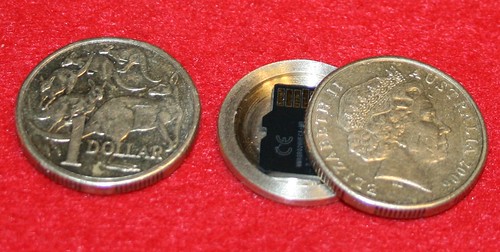
The MicroRoo, made from an actual Australian $1 coin, has the capacity to encapsulate the Micro SD memory card.
Ken Berger writes:
These hollow coins were referred as spy coins. Please see the Dereu & Sons Mfg. Co. website: spy-coins.com .Also see the FBI website: www.fbi.gov/about-us/history/famous-cases/hollow-nickel .
William Mills writes:
Thanks for the E-Sylum's! I am reading this one in the airport at Kuala Lumpur. I just wanted to add that I have in my collection what appears to be a contemporary Paraguayan 1870 4 Centesimo that is hollowed out. The obverse and reverse screw together. From the toning I would say it dates from the era that the coin was manufactured. Why it was made is anyone's guess.
To read the earlier E-Sylum article, see: MORE ON SECRET COMPARTMENT COINS (www.coinbooks.org/esylum_v14n40a10.html)
MORE ON SO-CALLED DOLLARS, INCLUDING A NEW BOOK
Jeff Shevlin the "So-Called Guy" writes:
I would like to make the following reply to the message from Dick Johnson regarding the definition of So-Called Dollars. I have a web site where collectors interested in So-Called Dollars participate in an active discussion board on topics related to So-Called Dollars. Collectors are helping to define the definition of just what is a So-Called Dollar and there are many opinions posted on his site by advanced collectors who are passionate on this series of historical US Medals.
The site was started just one year ago and currently averages over 7,000 unique hits each month. There are hundreds of photos of So-Called Dollars and the results of his last three Sealed Bid Auctions are available to view on-line. The site is www.So-CalledDollar.com .
Interest in So-Called Dollars has increased phenomenally in the past year and his web site is probably one of the most active in the hobby today.
Regarding so-called dollars, certainly the ultimate in the series, or close contenders, are the silver dollar size and obverse design embossed shell cards of 1867, 1868, and 1869. These use obverses stamped from dies, to which a metal reverse or a cardboard reverse is attached. They were produced during a time when silver dollars were not seen in circulation in the East or Midwest. Many of them were imprinted to be worth something if brought into a store. While most so-called dollars are really medals, this are about as close to a real dollar as you can get without actually being one!
Harry Lessin, John Ford, Steve Tanenbaum and others wanted to get a book out on these, as did the Token and Medal Society. Although TAMS has had articles, most notably a series started in 1961 by Ralph Mitchell and Russell Rulau, no one has ever had enough of these together to study them, except the late Steve Tanenbaum, who set about in 1977 forming a definitive holding. He eventually acquired what he wanted from the great collections, including Ralph Mitchell, Ray Byrne, John J. Ford, Jr. (with David Proskey and F.C.C. Boyd collections), and more.
That said, I am using Steve Tanenbaumâs work as the basis for a book, which is well underway. More information will be found in forthcoming issues of the TAMS Journal, Fred Reed editor. Any E-Sylum readers with information to share will be welcomedâ"just contact me at qdbarchive@metrocast.net
Jeff Shevlin adds:
The late Steve Tanenbaum was always going to provide me a copy of an auction catalog he had from the latter 1800âs that had a section in the back dedicated to So-Called Dollars, historical US medals approximately the size of a silver dollar.
To read the earlier E-Sylum article, see: QUERY: WHY IS THE DOLLAR CALLED A DOLLAR? (www.coinbooks.org/esylum_v14n40a11.html)
NOTES FROM E-SYLUM READERS: OCTOBER 2, 2011
Legal Guide for the Visual Artist
This didn't make it into last week's issue - sorry! Loren Gatch writes:
On the topic of currency mutilation, and legal reproductions of currency, I've found this source useful: Tad Crawford, Legal Guide for the Visual Artist 5th ed. (Alworth Press 2010).
In fact, if you search Google Books using "currency reproductions" as terms, you will find the snippet of the book that deals precisely with this issue (pp. 101-2).
To read the earlier E-Sylum article, see: QUERY: ART AND COIN MUTILATION LAWS (www.coinbooks.org/esylum_v14n39a16.html)
The Progression from Early Thalers to the U.S. dollar
Last week I asked " Can anyone point to a nicely illustrated page showing the progression from early thalers to the U.S. dollar?" Ken Bressett writes:
Perhaps not exactly what you asked for, but take a look at pages 126 and 127 of my book Milestone Coins, Whitman Publishing 2007, to see my explanation and pictures. I can send a scan of those pages if (heaven forbid) you donât have the book. Attached is a picture of an original Joachimstaler.
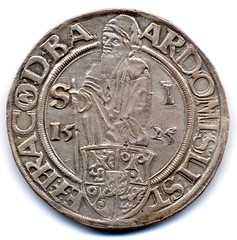
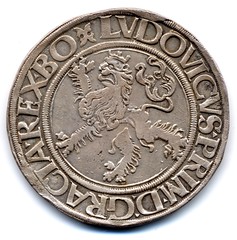
Maryland Paper Money Correction
Regarding last week's Featured Web Page, Ken Berger writes:
I went to the website you had listed & found the following statement: "Within the American colonies Maryland was the first to issue paper money in dollar denominations in 1766.".
This is highly misleading. According to Newman, these notes were authorized at the 1 November 1766 Session and payable between 25 June and 25 December 1777. The bills themselves are dated 1 January 1767 and, in fact, this is how Newman refers to them. Therefore, I would argue that the statement written by Giedroyc in his article is incorrect.
To read the earlier E-Sylum article, see: FEATURED WEB PAGE: HISTORY OF THE U.S. SILVER DOLLAR (www.coinbooks.org/esylum_v14n40a19.html)
The British Empire of Sorts
Reading the item in this week's edition reporting that "Canada Introduces Quarters Commemorating Things That Don't Exist," reminded me of a series of articles under the authorship of the late Carl Allenbaugh presented in 18 installments from August of 1971 through March of 1973.
Presented under the banner of "The British Empire of Sorts," the series addressed the then remnants of the British Empire which were still existing directly under the British flag, from Gibraltar to the Falkland Islands to the British Indian Ocean Territory and points far and wide between. While some had coinage distinct to their existence, these somewhat tongue-in-cheek presentations referenced both what existed and the whimsical coins that might be.
While none of the dozen or so whimsical designs offered up in the installments ever came to be, many of the entities which at the time did not boast distinct coinages were subsequently so recognized.
The installments made for interesting and entertaining reading.
To read the earlier E-Sylum article, see: CANADA INTRODUCES QUARTERS COMMEMORATING THINGS THAT DON'T EXIST (www.coinbooks.org/esylum_v14n40a17.html)
Books Impounded by Argentina
Argentina's booksellers are accusing the government of censorship, saying more than a million imported books have stacked up in customs as authorities try to rebuild the country's printing houses.
The dispute is about commerce, not ideology, and publishing houses are only the latest sector of the economy to experience the strong-arm tactics of a government determined to rebuild domestic industrial capacity.
President Cristina Fernandez didn't directly address the customs controversy Thursday night when she inaugurated the new Museum of the Book and the Language. But she said her government is dedicated to restoring Argentina's ability to take care of itself in an uncertain world.
"The world is going in one direction and at times it seems like we're going to the opposite, but this is the necessary path to recover a country that already knew how to do things," she said.
The newspaper Clarin published a lengthy article Thursday describing how in order to liberate their books from customs' impound warehouses, publishers have been forced to meet with representatives of Commerce Secretary Guillermo Moreno and present plans for shifting their production to domestic printing houses.
To read the complete article, see:
Argentina impounds imported books to force publishers to rebuild domestic printing industry
(www.chicagotribune.com/business/sns-ap-lt-argentina
-books-impounded,0,6281601.story)
More Numismatic Jokes
On the topic of numismatic jokes, martin Purdy has this to say about Pete Smith's " Did you know that 64 Kennedy Halves are now worth thirty-two dollars?". He writes:
The English version of this, which still catches people out sometimes (sorry if it's been mentioned before), is that 1920 pennies are worth 8 pounds (at 240 pre-decimal pennies to the pound ... work it out).
David Gladfelter writes:
This is old as the hills, but if you havenât heard it before: Which is worth more, six dozen dozen dimes or a half dozen dozen dollars? (Surprise! The dimes are worth $86.40 and the dollars $72.)
WHITMAN PUBLISHING LIMITED EDITIONS
QUERY: HELP DECIPHER NORTH CAROLINA STATE TREASURY NOTE SIGNATURE
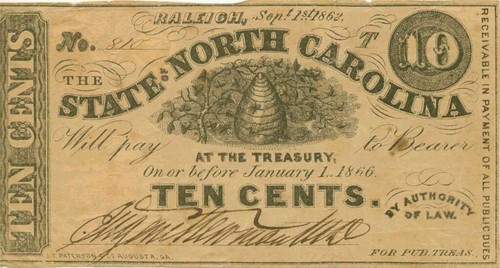
The attached is an image of a genuine 1862 10 cents North Carolina State Treasury note.
I would like any readers ideas as to what the signed name is. I have extensively researched the records in the NC State Archives and it is most definitely NOT that of any of the 63 signers that legitimately signed Treasury notes for North Carolina. This was in a small group of "trash" notes on EBAY a couple of years ago that I bought solely to obtain this note. I have never seen another note with a signature like this.
The serial number looks to be contemporary, and for this series is high, 810 T. Each signer (there was 33 for 1862 dated 10 cents notes) started at "1" for every note in a (serial lettered) sheet and continued on though his allotment.
This suggests a couple of possibilities:
1. The note was signed by a clerk or other unauthorized individual from an issuing location. If this is the case, it would have originated from the NC State Treasury Office, The Bank of NC in Raleigh, The Bank of Cape Fear from the either the Salem, Salisbury, or Asheville branch. I have not been able to make any "match" with any names associated with either of these locations.
2. Was "autographed" from a numbered sheet of remainders after the War was over, and the signature is a fantasy.
At any rate, if a reader would care to hazard a guess as to what the name is, I'd love to hear from them. I would like to write an article about this note and signature for future publication. As a bonus, there is no prize, but I'll include all the "translations" along with the submitters name in my article. Please, no "Billy Bob Smith" stuff, just real ideas!

MORE ON VICTOR JANVIER
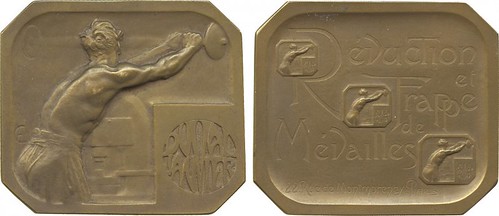
Last week Howard Daniel forwarded a description of a medal in a Baldwin's sale, I've bolded the part in question.
France, Duval L Janvier, medallist, octagonal Bronze Plaquette, c.1900, view of Janvierâs coining press, rev three reduced images of the obverse, Déduction et Frappe de Médailles, 22 Rue de Montmorency, Paris, 60mm x 52mm, in original card case (Jones, Art of the Medal 345; BDM VII 177).
Dick Johnson writes:
The name "Duval L. Janvier" as mentioned in Howard Daniel's submission form a Baldwin's auction in last week's E-Sylum is incorrect.
Duval was Janvier's partner -- not his first name. They were in business in Paris from 1892-? Janvier's first name was Victor. He patented his miraculous reducing machine in 1899, and died in 1911. After his death, the firm was taken over by Berchot, known first as Janvier & Berchot, and later simply as Le Medalier -- this is what what Franklin Mint acquired circa 1970.
Katie DeSilva (Jaeger) interviewed Joe Segel in 2005. She asked me for a list of questions to ask Joe. That was one of them: When purchased? What happened to it? He could not remember. Can anyone supply facts?
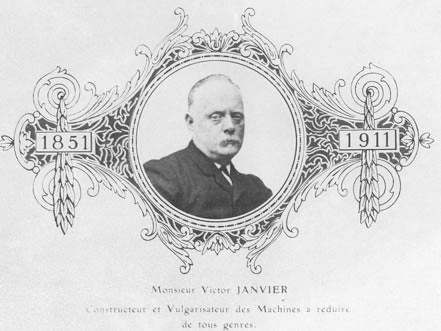
Victor Janvier's picture is in my medalblog: medalblog.wordpress.com/2010/12/27/janviers_pantograph/ .
To read the earlier E-Sylum article, see: NOTES FROM E-SYLUM READERS: SEPTEMBER 25, 2011: A Janvier Medal (www.coinbooks.org/esylum_v14n40a13.html)
SS GAIRSOPPA SHIPWRECK DISCOVERED BY ODYSSEY MARINE
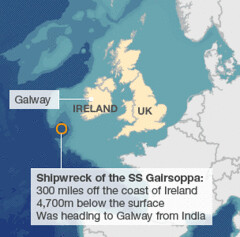 A shipwreck containing 200 tonnes of silver worth about £150m has been found in the Atlantic - the largest haul of precious metal ever discovered at sea.
A shipwreck containing 200 tonnes of silver worth about £150m has been found in the Atlantic - the largest haul of precious metal ever discovered at sea.
The SS Gairsoppa, a UK cargo ship sunk by a German U-boat in 1941, was found by US exploration firm Odyssey Marine.
Only one person from the 85-strong crew survived the torpedo attack as the ageing steamer tried to reach Ireland.
The vessel was on its way back to Britain from India when it ran low on fuel in stormy weather, and tried to divert to Galway harbour, but it was spotted and sunk by the German submarine.
The wreck of the 412ft ship was found this summer nearly 4,700m below the North Atlantic, 300 miles off the Irish coast, but it was only confirmed as SS Gairsoppa last week.
"Given the orientation and condition of the shipwreck, we are extremely confident that our planned salvage operation will be well suited for the recovery of this silver cargo."
SS Gairsoppa settled upright on the seabed with its cargo holds open, which means remote-controlled robotic submarines should be able to retrieve the bullion.
Work would begin in the second quarter of 2012, Odyssey said.
The seven million ounces of silver on the ship is a mixture of privately owned bullion insured by the UK government and state-owned coins and ingots.
To read the complete article, see: Shipwreck of SS Gairsoppa reveals £150m silver haul (www.bbc.co.uk/news/uk-15061868)
OBAMA AWARDS NATIONAL MEDALS OF SCIENCE AND TECHNOLOGY
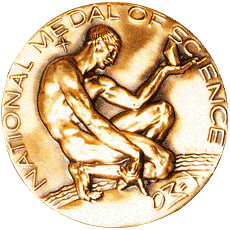 President Barrack Obama awarded 7 National Medals of Science this week to American researchers who have distinguished themselves in their respective fields. Among the honorees are 4 life scientists who have made seminal contributions in various areas of biology, including DNA structure and function, genetics, and biomedical engineering. Obama also named 5 inventors who will receive the National Medal of Technology and Innovation for contributing to the countryâs competitiveness. âEach of these extraordinary scientists, engineers, and inventors is guided by a passion for innovation, a fearlessness even as they explore the very frontiers of human knowledge, and a desire to make the world a better place,â Obama said in a statement.
President Barrack Obama awarded 7 National Medals of Science this week to American researchers who have distinguished themselves in their respective fields. Among the honorees are 4 life scientists who have made seminal contributions in various areas of biology, including DNA structure and function, genetics, and biomedical engineering. Obama also named 5 inventors who will receive the National Medal of Technology and Innovation for contributing to the countryâs competitiveness. âEach of these extraordinary scientists, engineers, and inventors is guided by a passion for innovation, a fearlessness even as they explore the very frontiers of human knowledge, and a desire to make the world a better place,â Obama said in a statement.
Here are the National Medal of Science winners, who will receive their awards from the president at a White House ceremony to be held later this year:
- Jacqueline K. Barton, California Institute of Technology, for the discovery of a new property of the DNA helix called long-range electron transfer and for showing that this process, which may aid in the repair of damaged DNA molecules, depends upon the specific arrangement of stacked base pairs and other DNA dynamics.
- Ralph L. Brinster, University of Pennsylvania, for his fundamental contributions to the development and use of transgenic mice.
- Shu Chien, University of California, San Diego, for pioneering work in cardiovascular physiology and bioengineering.
- Rudolf Jaenisch, Whitehead Institute for Biomedical Research and the Massachusetts Institute of Technology, for improving our understanding of epigenetic regulation of gene expression.
- Peter J. Stang, University of Utah, for his contributions to the development of organic supramolecular chemistry, which focuses on weaker and reversible, non-covalent interactions between molecules, and for his record of public service.
- Richard A. Tapia, Rice University, for his contributions in optimization theory and numerical analysis and for his efforts in mathematics and science education.
- S. R. Srinivasa Varadhan, New York University, for his work in probability theory, especially his work on large deviations from expected random behavior.
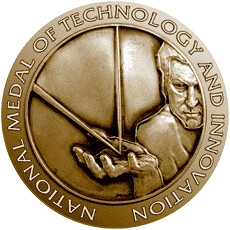 I've always found what I'll call "Achievement Medals" very interesting. Each recipient has a story, and the awarding of the medal connotes a great honor. You can't BUY one of these medals - you have to EARN it. Well, MAYBE you can buy them in the aftermarket on eBay. But by definition, these are very scarce medals - when so few are given each year, the total number issued is generally small.
I've always found what I'll call "Achievement Medals" very interesting. Each recipient has a story, and the awarding of the medal connotes a great honor. You can't BUY one of these medals - you have to EARN it. Well, MAYBE you can buy them in the aftermarket on eBay. But by definition, these are very scarce medals - when so few are given each year, the total number issued is generally small. Because these medals are so scarce and so rarely show up in the marketplace, it's difficult to place a value on them. And as a numismatist, it's equally hard to learn about them. Although the Internet has made this a little easier, there is often little information to be had regarding the artists who designed them, the engravers who made the dies, or the company that struck them. Wouldn't it be nice if there were a book we could turn to to learn about them?
Perhaps a "Top 10 (or 100?) Achievement Medals" survey would get the ball rolling. Certainly famous medals like the Pulitzer and Nobel Prize medals would achieve a high ranking, as would the Congressional Medal of Honor. Would the National Medal of Technology and Innovation make the cut? It could be easy to get bogged down in a long nomination process, but regardless of the size of the nominating pool it would be interesting to learn which medals come out on top. Who can generate the longest list of medal nominees? Send me your nominations and I'll compile the initial list. -Editor
To read the complete article, see: Seven New National Medal Winners (the-scientist.com/2011/09/29/seven-new-national-medal-winners/)
For more information on the medals, see: www.nationalmedals.org
THE BOOK BAZARRE
BOULTON AND WATT TO GRACE NEW £50 BANKNOTE
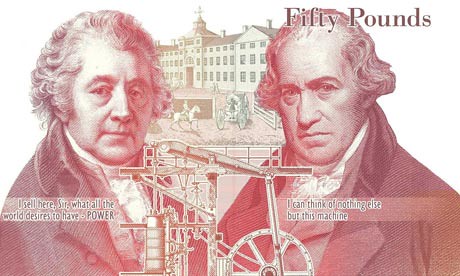
Sir Mervyn King, the governor of the Bank of England, has often voiced his yearning for a "rebalancing" of the economy towards neglected manufacturing, and he will put the nation's money where his mouth is next month when the Bank produces a new £50 note celebrating two pioneers of the industrial revolution.
The Bank will evoke the memory of the inventor James Watt and his Birmingham business partner, Matthew Boulton on the new note.
Threadneedle Street announced that the note, replacing one featuring the first governor of the Bank of England, Sir John Houblon, will go into circulation on 2 November. It will be the first to feature two people (in addition to the Queen) and the first to be signed by Chris Salmon, the Bank's new chief cashier.
Boulton, born in 1728, was an entrepreneur who started work in his father's Birmingham factory making buckles for shoes and knee-breeches, but he later built his own showpiece factory on Handsworth Heath.
He later went into partnership with James Watt, who took the Newcomen steam engine, then the latest design, and made a series of crucial improvements, improving its efficiency and making it more commercial.
By 1800, Watt's version was outselling its predecessor, and they were shipping it across the world. Boulton and Watt worked together to pioneer the use of the steam engine in the cotton spinning industry; and Boulton also used Watt's engine to power minting machines, pressing coins at his Soho Mint in Birmingham, to boost the supply provided by the Royal Mint.
To read the complete article, see:
£50 reward for industrial revolution pioneers on new bank note
(www.guardian.co.uk/business/2011/sep/30/50-pound-
reward-industrial-revolution)
AMAZON'S INCREDIBLE E-BOOK SALES GROWTH
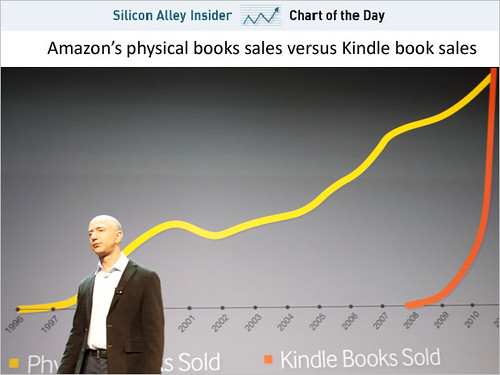
To read the complete article, see:
CHART OF THE DAY: The Incredible Growth Of Amazon's Kindle Book Sales
(www.businessinsider.com/chart-of-the-day-amazon-
kindle-book-sales-2011-9)
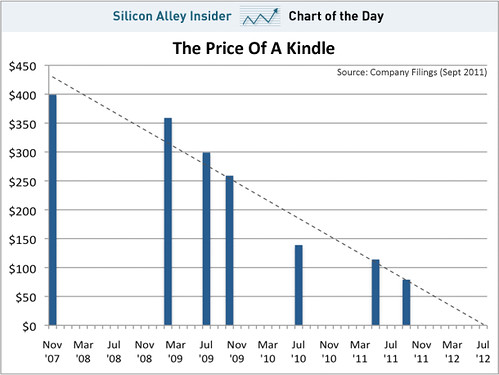
FROME HOARD OF ROMAN COINS DISPLAYED FOR PUBLIC
The largest collection of Roman coins unearthed in a single container goes on display to the public for the first time today.
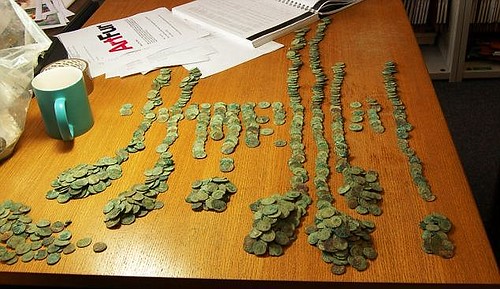
Table where the coins were sorted
The Frome Hoard, a collection of 52,503 silver and copper alloy coins unearthed by hospital chef Dave Crisp in April last year near the Somerset town that gives the hoard its name, is to go on show at the Museum of Somerset, in Taunton. Stephen Minnitt, Somerset County Council's head of museums, said it was a coup for the museum to obtain the 'highly important find'.
'The reason it was buried remains something of a mystery. Usually you tend to think of coin hoards being buried for safety in the times before there were banks, and those that are found today are the ones that were not recovered, presumably because the person that owned them had some sort of misfortune and didn't pick them up.
'In this case, though, the volume of coins in this very rounded pot - they weigh 160kg (353lb) - has led to the suggestion that they may well represent a votive offering of some sort. Precisely what, we don't know.'
Some of the coins have been completely cleaned to show what they may have looked like at the time they were buried. Others have been left in a condition closer to the way they looked when excavated.
All but five are made from a copper alloy which gives them a greenish tinge.
These five, which form their own display, are silver denarii of the emperor Carausius, an upstart from what is now the Netherlands who led a revolt against Rome in the last decade of the 3rd century AD and declared himself emperor of Britain and northern Gaul (France). They are among 760 coins from his reign of seven years.
'He was a usurper who took control of Britain and Gaul in AD296 and issued this very fine series of silver coins, which are exceedingly rare,' said Mr Minnitt.
'The five examples in the Frome collection are in mint condition. They are some of the finest examples of Carausius denarii ever seen.'
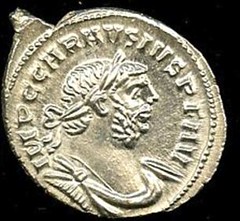
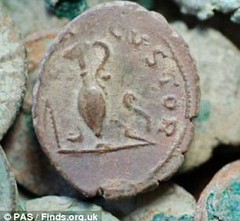
Silver denarius of Carausius Adventus, and a bronze coin
To read the complete article, see:
Largest collection of Roman coins found in a single container unveiled to the public for the first time
(www.dailymail.co.uk/news/article-2043141/The-Frome-Hoard
-Largest-single-collection-Roman-coins-display.html)
DOWNIES EMPLOYEE STOLE COINS TO BUY SPORTS CARDS

A RARE coin expert who stole more than half-a-million dollars worth of valuable coins and notes and sold them on eBay to fund an insatiable basketball card obsession has been sentenced to prison.
Marcus Loricchiella, 31, was yesterday sentenced in the County Court to serve 42 months' jail, with a 17-month minimum, for the stealing spree that spanned at least three years and saw him pocket more than $537,000 of valuable collectorâs items.
He pleaded guilty to five charges of theft and one charge of dealing with the proceeds of crime.
Loricchiella stole the items while he was employed as a rare coin expert at renowned dealer Downies Coins.
The court heard Lorichiella stole the valuable items and sold them on eBay then used the money to fund a bizarre obsession with Michael Jordan basketball cards, travel to New Zealand and Fiji and furnish his home.
He was employed by the company in 2004 but was sacked in July last year after a stocktake check uncovered the crimes.
To read the complete article, see:
Coin collector jailed for stealing from boss to fund odd sports card habit
(www.heraldsun.com.au/news/more-news/coin-collector
-jailed-for-stealing-from-boss-to-fund-odd-sports-card-habit
/story-fn7x8me2-1226148043490)
FEATURED WEB PAGE: 1715 FLEET SOCIETY
This week's Featured Web Page is recommended by Ray Williams, who writes: "Fast approaching is 2015 - the anniversary of the wreck of the 1715 Fleet off the coast of Florida in a hurricane."
Florida in the 18th century remained an isolated outpost of the Spanish Empire, its most important mission to secure the homeward route of the Spanish New World Treasure Fleets. These fleets had long funded Spain's now-declining role in European & world affairs. The loss of the 1715 Fleet was another blow to the newly established Bourbon dynasties of Spain. Gold and silver in great quantity was homeward bound to Philip V when a hurricane destroyed his fleet along Florida's coast.
Some recovery in the aftermath still left much to be recovered beginning in the 1960's and ongoing to this day. Much research remains to be done on the 1715 Fleet and its treasure. The State of Florida has a accumulated a magnificent and yet little studied collection of Fleet material. The 1715 Fleet Society aims to promote public awareness and scholarly study of all facets of the 1715 Fleet disaster.
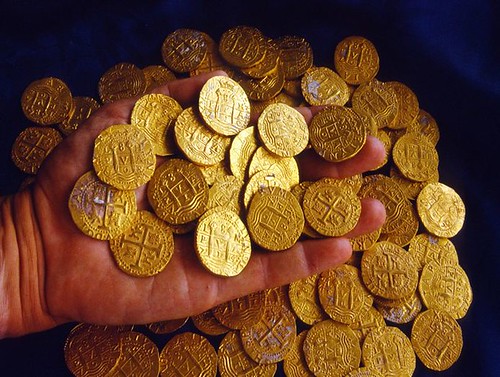
www.1715fleetsociety.com

